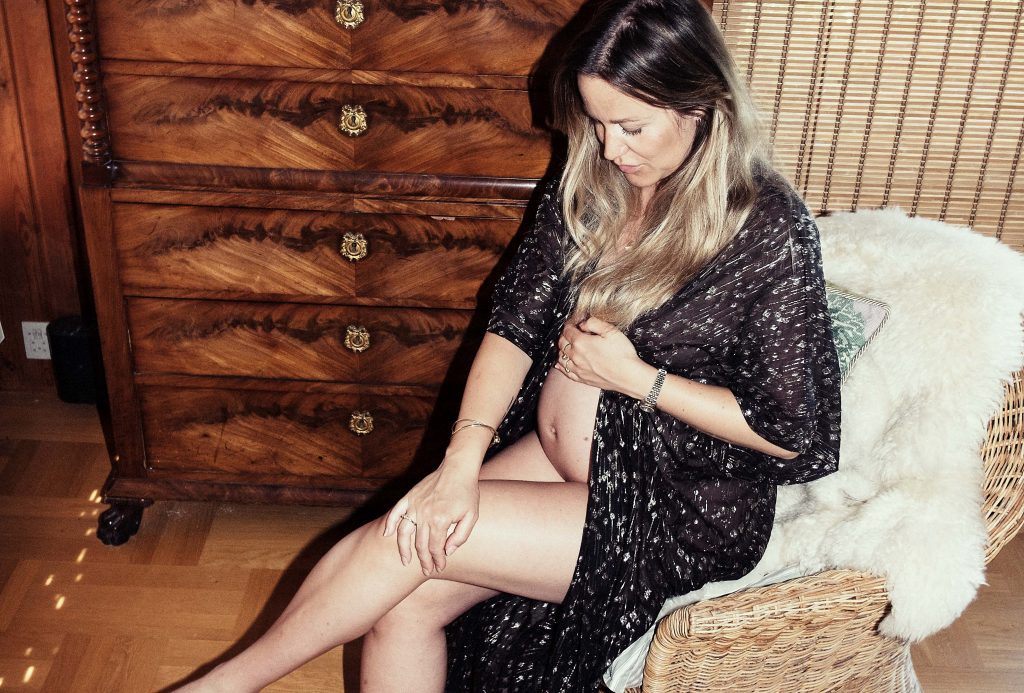
Blogger Emily Salomon’s story
On one of the hottest days of the year, we meet blogger Emily Salomon in the coastal village of Hornbæk where she’s enjoying her maternity leave at her parents’ summer cottage. With her due date just a few weeks away, she reflects on her journey to pregnancy — talking candidly about her experiences with PCOS, miscarriage and fertility treatments — before heading to the beach with her dog Penny for a sunset dip in the cooling sea.
A routine gynaecological check-up at 16 revealed that Emily Salomon suffered from polycystic ovary syndrome (PCOS), a common condition that affects the way the ovaries work, resulting in irregular periods and often hindering a woman’s ability to become pregnant. Almost two years ago to the day, Emily was sitting in her doctor’s office together with her husband, Nikolaj. After trying to conceive naturally for about six months, they sought help in a process that would turn out to be a 24-month rollercoaster ride of fertility treatments, a lifestyle reboot, miscarriage, two very visible lines on a pregnancy test and, ultimately, a baby boy due later this month.
“As part of our pregnancy journey, we tried artificial insemination. I had a very bad reaction to the hormones so decided to stop after just one attempt, to dedicate one year to a total lifestyle overhaul in the hope of falling pregnant,” Emily recalls.
“It takes a lot of effort; you need to sleep regularly and adequately, take blood sugar stabilisers and, ironically, avoid stress. It can seem bewildering, but [the process] isn’t necessarily cut and dry. You can quite easily undergo fertility treatment while doing one or more of the above — or none. Although I remember that when we asked the doctors what we could do ourselves to help the process, the answers were few and far between and along the lines of ‘avoid excessive amounts of fizzy drinks and exercise.’”
Science has made huge advancements in recent years that it seems almost possible for doctors to impregnate a football, Emily says sarcastically, but it doesn’t mean they should come at the cost of informing patients of natural alternatives to help a woman become pregnant. Emily and her husband ended up taking a more natural approach to conception.
“I visited a gynaecologist for a check-up after changing my day-to-day habits and he noted that it was impossible to see that I suffered from PCOS. Already then, the change was massive and, although not evidence-based, it was really thought provoking. I’d love to see a routine gynaecological check-up for women aged 21. Many women take the pill for 15-20 years, without knowing the effect it has on the body. We spent two and a half years trying to get pregnant, but I could just as well have concentrated on stabilising my hormones before deciding to try for a baby. The pill is a brilliant method of contraception, especially for preventing unwanted teenage pregnancies, but wouldn’t it be great if doctors were better at informing women about what exactly it is so that they can make an informed decision on whether or not to take it?
When I was told that I had PCOS, my doctor prescribed a very potent contraceptive pill. After subsequently trying different versions and just not getting on with the medicine, I stopped taking the pill at 20. I also stopped getting regular periods. But felt better in so many other ways: my mood was lifted; my weight was stable; my headaches disappeared. The pill can often mask the symptoms of PCOS in young women and in some cases ease them, but it doesn’t help them become pregnant in the long run.”
The first miscarriage
After a significant shift in exercise routines, diet, sleep habits and stress management for both Emily and her husband, she finally conceived naturally. But on a weekend visit to Aarhus, Emily had a miscarriage and was admitted to hospital.
“For the first time since I started blogging, I experienced my job as challenging. Sharing my daily life experiences with my followers suddenly became so hard. It was really difficult to feel so sad and to not be able to share the reason why. I wanted to tell [my followers] about the miscarriage and let them know I was grieving, but I was so overwhelmed and felt very alone and misunderstood by the system.
One of the doctors said to me, ‘the pregnancy tissue is out now.’ Their comments like, ‘it’s good that you know you can get pregnant’ or ‘it happens in 20% of all early pregnancies’ were very poor consolation. That may well be true, perhaps even constructive with the passing of time, but in the depths of my grief it felt condescending. When you’ve just had a miscarriage, the last thing you need is a statistic or to be told to get back on the horse again.
I know others who have experienced miscarriage and I’ve probably reeled off the same clichés [to them], but it’s only since having been through it personally that I understand the pain of miscarriage—emotionally as well as physically. It feels like losing a loved one. My friend told me to take a week off work and camp out on the sofa with the Harry Potter back catalogue. It felt good to allow myself to be sad. I knew that I wanted to share my story and I found comfort in those who had been through the same, but chose to first write about it a year later when I fell pregnant again.”
Fertility and fellowship
“Early on in our relationship, my husband and I agreed that our mutual happiness wasn’t dependent on having a baby. Coupled with a somewhat naive belief that it would all work out in the end, our relationship has gone from strength to strength. Many couples struggle to conceive, but the majority succeed. I took a statistical approach to conception and found comfort in the fact that it would, in all probability, happen at some point. The frustrating thing was not knowing when. I didn’t want to look back on one, two, five years of my life and think they were the worst years ever, but that doesn’t mean to say I haven’t been frustrated and upset or thought, ‘why can’t this body do what it’s supposed to?’”
Emily shared her struggle with family and close friends and has since become an advocate for a more tactful approach to addressing women and their burgeoning bellies.
“You should never ask a woman if she is pregnant. Never. By doing so, you’re either inadvertently saying she’s put on weight or risk spoiling her surprise. Worse still, you could end up rubbing salt in the wounds of people who are struggling to conceive. It could also be a conscious decision to not have a child. People automatically assume that having a baby is the next logical step in a relationship—especially if you’ve just got married.”
How was your pregnancy?
“Truly magical. I discovered that I’m really bad at getting pregnant, but really good at being pregnant! I’ve had an easy pregnancy so far and felt really energetic. I was pretty nauseous during the first trimester. The only thing that seemed to get me through it was hotdogs. I was a bit panicky until I felt my baby moving and it took me a while to believe that this pregnancy was actually real. But that all changed when I felt my baby kick for the first time.”
How did you discover you were pregnant?
“I was at home and I just knew. I’ve taken so many pregnancy tests, trying to make sense of the shadowy lines, so I decided to wait a couple of weeks before taking this one. When I did, there they were: two distinctive lines.”
How do you feel about your pregnant body?
“On the whole, good. It was a little difficult at first as my breasts grew quickly, which made it hard to fit my clothes. I started showing around week 16 — and I didn’t have to hide it anymore either, which made it a lot easier. Initially, I had decided to wear jeans and oversized shirts throughout my pregnancy but soon discovered that close-fitting clothing worked much better. I looked like a tent in a billowy dress. I bought a few items from Boob Design, a Swedish maternity brand, as well as maternity trousers and exercise tights from H&M, which I’ve lived in for most of my pregnancy.”
What do you miss most?
“Initially, I just dreamed about eating hotdogs, going to festivals and swimming in the sea —all of which aren’t exactly winter activities. Besides the hotdogs. These last few weeks of pregnancy have been spent resting and nesting. The need for the latter is actually quite extreme now as I haven’t really allowed myself to prepare for fear of jinxing it all. Halfway through my pregnancy, a friend frogmarched me to the shops to buy bodysuits and dummies for the baby as I’d bought nothing. The whole thing became so much more real when we set up a baby chair recently and I’ve gone into full-on nesting mode. Even with things that have nothing to do with the baby.”
Which shoes have carried you through your pregnancy?
“Havaianas have been indispensable these past weeks. Otherwise, I’ve worn everything from heels to trainers and Birkenstock sandals.”
How has your beauty regimen changed?
“I’ve had a bit of a clear out, but nothing major. In general, my beauty products are low on parabens and other nasties. I spray my perfume into my hair or onto my clothes and use less nail polish than usual.”
And what about diet and supplements?
“I’ve taken multivitamins, fish oil capsules, vitamins C and D, and zinc. As I don’t eat a lot of dairy, I’ve also taken calcium supplements and magnesium before bed has helped with cramps.”
Labour pains
“Early on in my pregnancy I dreamt that I had a really good labour. Besides that, I’ve always been terrified of giving birth. As funny as it sounds, the dream actually helped allay my fears and I’ve since felt that it will be just fine. I’m not one to read labour stories or ask women to recount their experiences giving birth, but I’ve listened to the Swedish podcast ‘Vattnet går’ [When the waters break, –ed.] and have gone through about 100 birth stories, good and bad. It’s given me a new-found respect for labour and an understanding of just how different each one is.
I plan on giving birth to my son at Copenhagen University Hospital’s new maternity ward. Based on a Norwegian study that a midwife’s continuous presence during labour is key to a positive and spontaneous birth experience, the ward has no doctors and only natural pain relief. Having said that, I’m open to a different labour — an epidural, a suction cup, a C-section – as long as my baby is safe and healthy.”
How are you preparing for giving birth?
“I followed a programme called Pain-free Labour, consisting of four sessions and one of which Nikolaj attended. I don’t expect giving birth to be painless, but I feel the course has prepared me for labour. I also took part in the hospital’s antenatal class, which was really informative. Although the second module left me fuming about their arbitrary approach to postnatal care. They recommended we watch YouTube videos about breastfeeding, to ‘search away and see what’s good and what’s bad.’ On the whole, they placed so much importance on breastfeeding. The Danish National Health Service recommends breastfeeding exclusively for the first 6 months, but only 12% of new mothers succeed in this, with the majority opting to bottle-feed within the first few weeks. It’s not a criticism of what’s going on on the maternity ward, but rather a reproach against a system that sends women home so quickly after giving birth and fails to properly equip adults for the first few weeks of parenthood.
I subsequently created a series of stories on Instagram about my experience and received comments from more than 200 women, the majority of whom had faced major challenges during childbirth. I really believe it’s a nationwide problem. There were also a number of comments from healthcare professionals who expressed their frustration at sending women home too early and attending to babies too late in the process.
My frustration was based on a wider concern that we risk creating a division between those who can afford to pay for help and those who can’t, impacting the outcome [of breastfeeding] tremendously. Breastfeeding is a personal choice, but all women should have the same chance of success and qualified help on hand. [The health service approach] seems so narrow-minded, especially given the potential consequences. To me, it seems like a no-brainer to invest in postnatal care. I’ve since been contacted by the chief midwife at Copenhagen University Hospital, a super cool woman who’s invited me to discuss what constitutes a good prenatal class. I’m pencilling it in my diary for after the baby arrives.”
Text Bea Fagerholt Photo Liv Winther
MEET’N’GREET
Blogger Emily Solomon, 33, and Nikolaj Vang are expecting their first child. The couple has been together for 3.5 years and Emily is due on July 25th.
Read more about Emily here.

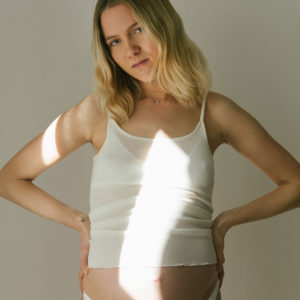
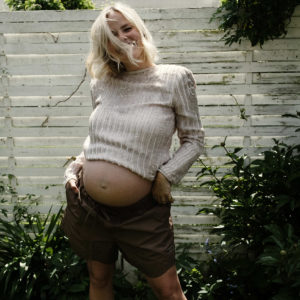
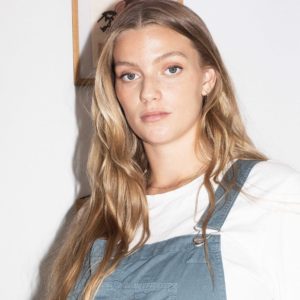
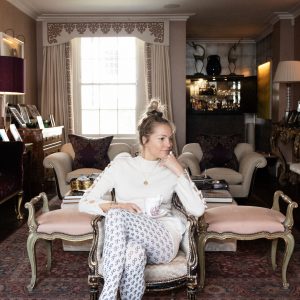
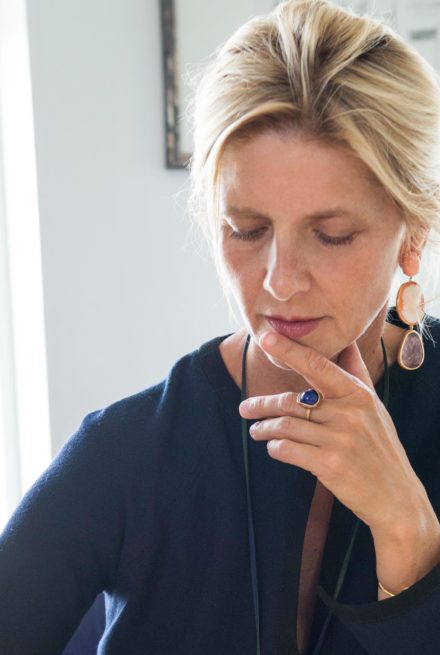
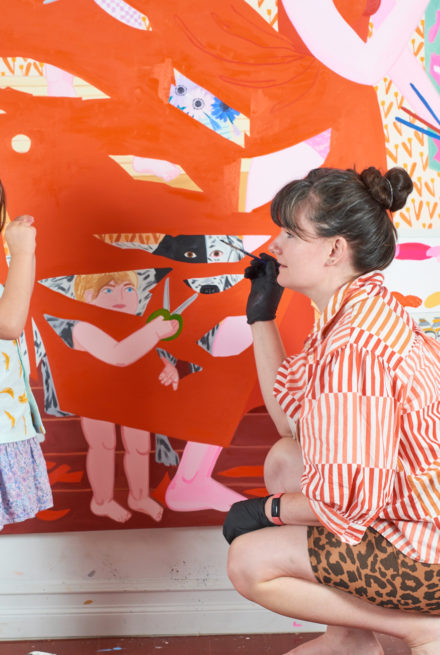
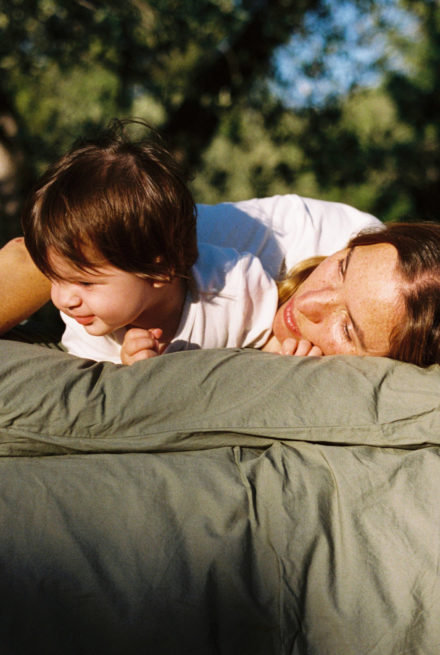
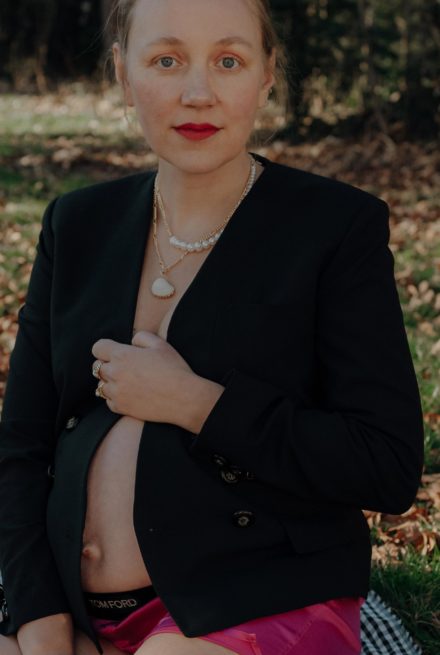
Din kommentar